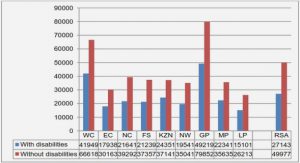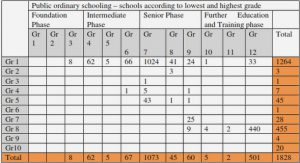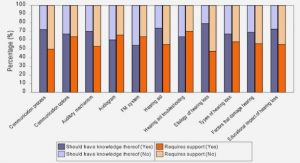Get Complete Project Material File(s) Now! »
Structural properties of III nitrides
III-nitrides including binary, ternaries and quaternaries of (B, Al, Ga, In)N have two types of crystalline structures: hexagonal and cubic. Under the typical MOVPE growth condi-tions, they crystallize in the most thermodynamically stable form into wurtzite structure, except that the BN favors hexagonal (graphitic) prototype. As shown in Fig. 8, wurtzite crystallographic structure has nitrogen atoms forming a hexagonal close packed structure while the group III elements occupying half of the tetrahedral sites available in the lat-tices. Or it can be seen as two interpenetrating hexagonal close packed sub-lattices, and each sub-lattice is shifted along c-axis by 3/8 of the cell height. Each atom in the lattice is tetrahedrally coordinated. Typical crystal orientations and planes of wurtzite III-nitrides are illustrated in Fig. 9.
Since there is a large disparity of electronegativity between III elements and nitrogen atoms with small atomic radius, the III elements and nitrogen are bound by strong covalent bonds. Therefore, III-nitrides are chemically and physically stable. III-nitrides also show high thermal conductivity as seen in Tab. 2. Owing to their structure and thermal stability, III-nitrides are suitable candidates for high temperature and high power applications. The lattice parameters of hexagonal BN, AlN, GaN and InN are summarized in Tab. 2. The a; c(Ax B1 x N) = a; c(AN) x + a; c(BN) (1 x) : (1).
One of the technical challenges of III-nitride applications is the lack of lattice-matched substrates. Commercially available, low-cost and thermal stable sapphire substrates were used in the majority of the research work. Although it has large lattice mismatch with III-nitrides, GaN templates grown on sapphire have already been achieved with the dislocation density down to 108 cm 2 by using low temperature nucleation layer, which was pro-posed by Nakamura in 1991 [83], and they have been widely used for visible and near-UV light emitting devices. For DUV devices, the high quality AlN substrates are still under investigations now and the method to reduce dislocation densities is an important topic.
Critical thickness for AlGaN grown on AlN templates
This subsection attempts to predict critical thickness range of AlGaN layers grown on AlN templates by applying di erent theoretical models reported in the literature.
The theoretic model of calculating critical thickness of epitaxial layers was first pro-posed by J.H. van der Merwe [128, 129]. He initially formulated a misfit dislocation theory for critical thickness of strained layers assuming that the crystal would reach thermody-namic equilibrium and settle into the lowest energy state [128]. In brief, the critical re-laxation point is where the interfacial energy I between the film and the substrate for generating dislocations is equal to the strain energy in the film [6]. The interfacial energy I can be expressed by the following equation (for moderate misfit f 4%): I = 9:5 f ( Gb 4 2); (18).
where G is the shear modulus and b is the slip distance (or Burgers vector). The areal strain energy density associated with a film of thickness h is: 1 + )h f 2 ; H = 2G( (19).
1 where is Poisson’s ratio. By setting I = H , the critical thickness hc can be obtained: hc ’ ( 9:5 )( 1 ) b ; (20) 8 2 1 + f.
where a0 is the bulk lattice constant of the substrate. Matthews-Blakeslee mdoel (MB) J.W. Matthews and A.E. Blakeslee have proposed Matthews-Blakeslee model for pre-dicting the critical thickness via mechanical equilibrium theory instead of minimizing the total energy of strain and dislocations in a crystal [130].
Figure 18 shows a grown-in threading dislocation in coherent interface (a), critical in-terface (b) and incoherent interface (c). FD is the tension in the dislocation line and FH is the force exerted on the dislocation line by misfit stress. For the film thickness ha, the interface is assumed coherent; for the thickness of hb, the interface is critical (FH = FD); and for hc where FH > FD, the dislocation is elongated in the plane of interface forming a misfit dislocation (MD) line with length LL’ [6, 130]. Assuming that the elastic constants of the two media A and B are equal, FH and FD are given as: FH’G( 1 + )bh Gb2 h FD ’ [ln( )+1] :1 (21) .
Estimation of threading dislocation densities by XRD
[0 0 0 1] oriented III-nitrides normally contain three types of threading dislocations (TDs): a-type (edge) with b = 1/3<1 1 -2 0>, c-type (screw) with b = <0 0 0 1> and a+c type (mixed) with b = 1/3<1 1 -2 3>. Each dislocation type accommodates a lattice distortion. Edge TDs lead to a lattice twist, screw TDs lead to a lattice tilt and mixed TDs contributes to both.
In order to study the structural quality of substrates, epitaxial layers or devices, XRD is an e ective and non-destructive method, which is not only for determination of com-position but can also provide information on threading dislocation densities in the layers including both edge and screw types (components). !-scans of symmetric planes can mea-sure quantitatively the lattice tilt from screw TDs or screw component of mixed TDs. Twist caused by edge TDs or edge component of mixed TDs should be measured by skew sym-metric !-scans, because asymmetric ! scans are sensitive only to tilt [106]. FWHM (full width at half maximum) of a skew symmetric rocking curve is broadened by both tilt and in-plane twist, so a series of skew symmetric rocking curves for di erent planes (di erent inclination angle ) should be done to separate tilt angle and twist angle, as expressed in Eq. 31, which is particularly useful for high defective layers such as AlN [106, 135]: 2 = ( 2twist 2tilt)sin2 + 2tilt ; (31).
where is FWHM angle of the skew symmetric rocking curve, tilt and twist are the tilt and twist spread, and is inclination angle between the reciprocal lattice vector and the c axis. Then, the densities of screw TDs and edge TDs may be estimated by Eq. 32 Nscrew = 2tilt=(4:35 b2c) (32) Nedge = 2twist=(4:35 b2a) .
where the Burgers vector of screw type TDs (bc) and edge type TDs (ba) can be seen equal to the lattice c and lattice a of the material.
Skew symmetric rocking curves have been done for AlN/sapphire template, 29-nm Al0:57Ga0:43N layer and 630-nm Al0:58Ga0:42N layer in order to investigate the quality of the substrates and epitaxial layers. bc is 0.4982 nm for AlN and 0.5067 nm for Al0:58Ga0:42N, and ba is 0.3112 nm for AlN and 0.3144 nm for Al0:58Ga0:42N. The measured data to iden-tify tilt and twist angle are shown in Fig. 21, and TD densities are summarized in Tab.
MOVPE growth of BAlN with high boron content
Compared with conventional AlGaInN system, Boron containing III nitrides are quite new in this family. They are suitable for DUV applications because of their wide bandgaps, and they can bring additional freedom in engineering the bandgap, lattice constant and refractive index of multi-layered devices. Most of the studies concentrate on BAlN single layers with only 1 2% boron. High boron containing layers grown by MOVPE have not been progressed a lot. This section describes the growth and characterizations of BAlN layers or heterostructures with high boron incorporation. The properties of the materials are studied and discussed.
BAlN/AlN grown at 1000 C
The fabrication of BAlN/Al(Ga)N heterostructures is an important issue which needs to be further developed no matter for BAlGaN-based MQWs or for DBRs. BAlN/Al(Ga)N heterostructures were grown at 1000 C by both flow-modulate epitaxy (FME) and con-ventional continuous method. The experiments were performed in T-shape reactor at 133 mbar by using hydrogen as carrier gas. In this subsection the samples by FME method are analyzed in details, and the results of this part can also be found in Ref. [136]. The structural quality of the heterostructures grown by continuous method is investigated in the subsection 5.4.1 for DBRs.
The samples consist of 5-period AlN/BAlN layers (25 nm / 32 nm) on two types of substrates: 1 m AlN templates on sapphire and 3 m GaN templates on sapphire. The AlN templates are appropriate substrates for deep UV applications while GaN templates were used as reference. The temperature was maintained at 1000 C during the growth and TEB/III molar ratio in the vapor phase was 39% in order to have high boron incorporation. Flow-modulate epitaxy (FME) was applied during the growth of BAlN layers in order to enhance the migration of B and Al atoms and also to suppress parasitic reactions [72,
Table of contents :
CHAPTER 1 INTRODUCTION
1.1 Motivation
1.2 Research problems
1.3 State-of-the-art
1.4 Scope of the thesis
CHAPTER 2 FUNDAMENTALS OF MATERIALS AND EXPERIMENTS
2.1 Fundamental properties of III nitrides
2.1.1 Structural properties of III nitrides
2.1.2 Optical properties of III nitrides
2.2 Experimental methods
2.2.1 Metal-organic vapor-phase epitaxy
2.2.2 Characterization techniques
CHAPTER 3 MOVPE STUDIES OF BAlGaN MATERIALS
3.1 MOVPE growth of AlGaN single layers
3.1.1 Control of composition and relaxation
3.1.2 Critical thickness for AlGaN grown on AlN templates
3.1.3 Estimation of threading dislocation densities by XRD
3.2 MOVPE growth of BAlN with high boron content
3.2.1 BAlN/AlN grown at 1000 C
3.2.2 BAlN grown at low temperature with annealing
CHAPTER 4 DEEP UV AlGaN MQWS: DESIGN, GROWTH AND CHARACTERIZATIONS
4.1 AlGaN MQW design for enhanced TE (E?c) emission
4.1.1 Principles of AlGaN band structure calculation
4.1.2 Design of AlGaN MQWs
4.2 Growth and characterizations of MQWs
4.2.1 Structural characterizations
4.2.2 Optical characterizations
4.3 10- and 20-period MQWs
4.4 Defects in MQWs and their influence on DUV emission
4.4.1 Structural investigations of defects
4.4.2 Optical influence of defects in AlGaN MQWs
CHAPTER 5 DISTRIBUTED BRAGG REFLECTOR: SIMULATIONS AND REALIZATION
5.1 Transfer-matrix simulations of DBRs
5.2 Design of BAlN/AlGaN DBRs
5.3 Simulation of structural quality factors
5.3.1 Roughness
5.3.2 Influence of lattice strain
5.4 Realization of BAlN/Al(Ga)N DBRs for DUV
5.4.1 Growth conditions for DBRs
5.4.2 BAlN/Al(Ga)N DBRs with reflection at DUV wavelengths
5.4.3 Characterizations of DBRs and reflectance comparison with simulations
CHAPTER 6 CONCLUSION AND PERSPECTIVE
6.1 Conclusion
6.2 Perspective
6.3 Publications and awards
References




